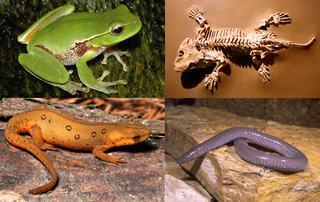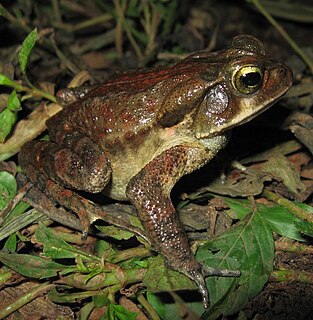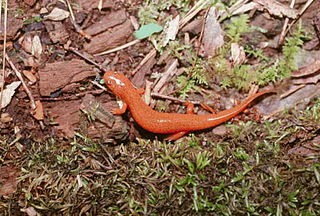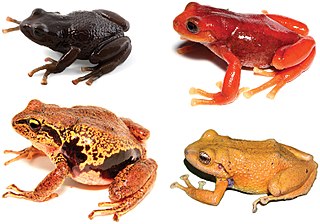
Amphibians are ectothermic, tetrapod vertebrates of the class Amphibia. All living amphibians belong to the group Lissamphibia. They inhabit a wide variety of habitats, with most species living within terrestrial, fossorial, arboreal or freshwater aquatic ecosystems. Thus amphibians typically start out as larvae living in water, but some species have developed behavioural adaptations to bypass this.

Herpetology is the branch of zoology concerned with the study of amphibians and reptiles. Birds, which are cladistically included within Reptilia, are traditionally excluded here; the scientific study of birds is the subject of ornithology.

Ambystomatidae is a family of salamanders belonging to the order Caudata in the class Amphibia. It contains two genera, Ambystoma and Dicamptodon. The family contains 32 species and are distributed widely across North America. These salamanders are mostly terrestrial and eat invertebrates, although some species are known to eat smaller salamanders. They can be found throughout the US and some areas of Canada in damp forests or plains. This family contains some of the largest terrestrial salamanders in the world, the tiger salamander and the coastal giant salamander. Some species are toxic and can secrete poison from their bodies as protection against predators or infraspecific competition. Neoteny has been observed in several species in Ambystomatidae, and some of them like the axolotl live all of their lives under water in their larval stage.

Megophryidae, commonly known as goose frogs, is a large family of frogs native to the warm southeast of Asia, from the Himalayan foothills eastwards, south to Indonesia and the Greater Sunda Islands in Maritime Southeast Asia, and extending to the Philippines. Fossil remains are also known from North America. As of 2014 it encompasses 246 species of frogs divided between five genera. For lack of a better vernacular name, they are commonly called megophryids.

Ptychohyla is a genus of frogs in the family Hylidae. These frogs are found in the southern Mexican states of Chiapas, Guerrero, and Oaxaca, and Central America to western Panama.

Pseudacris is a genus of frogs in the family Hylidae found in North America ranging from the Pacific coastline to the Atlantic.
Oedipina complex, commonly known as the Gamboa worm salamander, is a species of lungless salamander found in western South America from Costa Rica to western Colombia and north-western Ecuador. This species inhabits humid tropical lowland forest where it can be found on the ground, and on bushy vegetation, logs and rocks. It can also be found on forest edges, but it does not survive in degraded areas. Deforestation is a threat to this species.

The Cycloramphidae are a family of frogs endemic to southeastern Brazil. This family has seen large changes in its composition. Genera that have at some point been included in the Cycloramphidae are at present placed in the Alsodidae, Hylodidae, Leptodactylidae, and Rhinodermatidae. Of these, the Alsodidae and/or Hylodidae have also been considered as subfamilies of Cycloramphidae ; the Cycloramphidae, as recognized at present, would be similar to subfamily Cycloramphinae under such system.

Necturus is a genus of aquatic salamanders native to the eastern United States and Canada. They are commonly known as waterdogs and mudpuppies. The common mudpuppy (N. maculosus) is probably the best-known species – as an amphibian with gill slits, it is often dissected in comparative anatomy classes.
Amphibian Species of the World 6.1: An Online Reference (ASW) is a herpetology database. It lists the names of frogs, salamanders and other amphibians, which scientists first described each species and what year, and the animal's known range.

Rhinella pombali is a hybrid species of toad from south-eastern Brazil, named after José Perez Pombal, Jr., a Brazilian herpetologist. It was originally described in 2004 as a distinct species, but a genetic study published in 2012 found it to be a hybrid of Rhinella ornata and Rhinella crucifer; it is also morphologically intermediate between these species. It is therefore no longer considered a valid species, although it is still present in some listings.

Paratelmatobius is a genus of frogs in the family Leptodactylidae. They are endemic to southern Brazil.

Pseudotriton is a genus of salamanders in the family Plethodontidae. They are endemic to eastern and southern United States, from New York south to Florida and west to southern Ohio, Kentucky, Tennessee, and eastern Louisiana. They are commonly known as red salamanders or mud salamanders.

Craugastoridae, commonly known as fleshbelly frogs, is a family of New World direct-developing frogs. As delineated here, following the Amphibian Species of the World, it contains 123 species. They are found from the southern United States southwards to Central and South America.

The Pelodryadinae are a subfamily of frogs. The classification of this taxon is disputed.

The Odontophrynidae are a family of frogs from southern and eastern South America. This family was first established in 1969 as the tribe Odontophrynini within the (then) very large family Leptodactylidae. Molecular phylogenetics analyses prompted the move of this group to the Cycloramphidae in 2006, before they became recognized as their own family Odontophrynidae in 2011.

Hylodidae is a family of frogs. Whether their sister taxon is the Dendrobatoidea or Alsodidae is still under debate. They are native to Brazil and northern Argentina.
AmphibiaWeb is an American non-profit website that provides information about amphibians. It is run by a group of universities working with the California Academy of Sciences: San Francisco State University, the University of California at Berkeley, University of Florida at Gainesville, and University of Texas at Austin.















